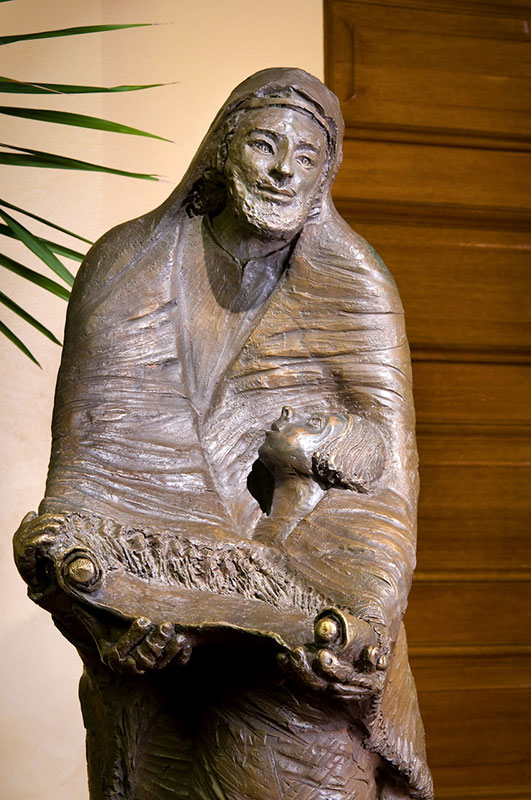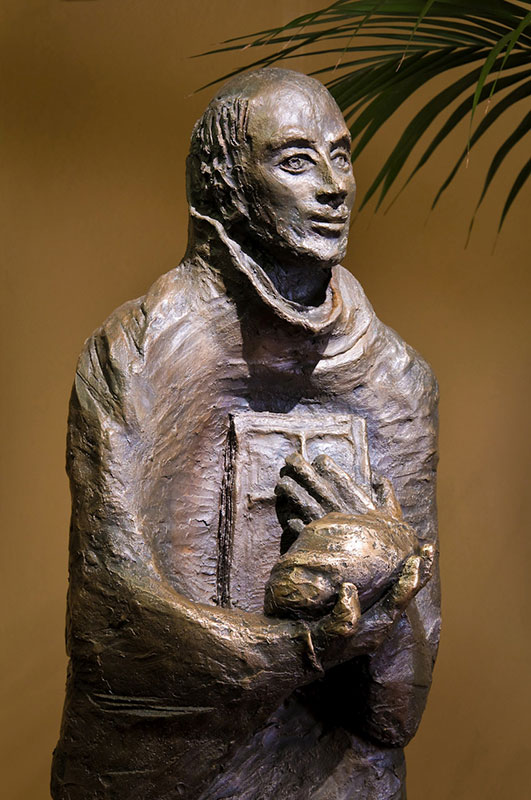 Pauline Clayton worked as a sculptor in Melbourne and her works are featured in various institutions, including St Francis’ Church, Lonsdale Street, and schools, including Catholic Ladies College, Eltham. In addition to juggling the responsibilities of marriage, helping to raise three children and teaching, Pauline undertook art classes at the Royal Melbourne Institute of Technology (RMIT) and taught art and sculpture in secondary schools, including Geoghegan College, Broadmeadows and Genazzano fcj College, Kew, VIC.
Pauline Clayton worked as a sculptor in Melbourne and her works are featured in various institutions, including St Francis’ Church, Lonsdale Street, and schools, including Catholic Ladies College, Eltham. In addition to juggling the responsibilities of marriage, helping to raise three children and teaching, Pauline undertook art classes at the Royal Melbourne Institute of Technology (RMIT) and taught art and sculpture in secondary schools, including Geoghegan College, Broadmeadows and Genazzano fcj College, Kew, VIC.
Writing in honour of Pauline after her death in 2012, Rosemary Crumlin oam paid tribute to Pauline’s passionate support of women in indigenous cultures, working and living alongside aboriginal communities and learning from their history, culture and art and helping them in return1. Often enough, her sculptures for churches and schools are cast in bronze and carry the fingerprints of those for whom she was creating the art, as a sign of their shared collaboration in bringing the artistic ideas to birth.
At St Francis’ Church, often regarded as the spiritual heart of Catholicism in Melbourne, two of Pauline’s sculptures are situated in the left (‘north’) transept, adjacent the sanctuary. St Francis’ Church is considered to be Australia’s busiest Mass centre, with up to 10,000 people from different cultures passing through its doors each week. The daily round of Eucharist, Morning and Evening Prayer, Reconciliation, and devotional exercises (including Rosary and Novenas) make the church a spiritual oasis within a busy metropolis. The expressive warmth of the wooden panelled walls, decorative wooden ceiling and carpeted floor provide a homely context for artistic works that evoke prayer, reflection and devotion.
 The bronze statue entitled Joseph (1998) is so named to embrace both the figure of Joseph, Son of Jacob, as well as St Joseph, father to Jesus. Archivist Damien Cash comments: As I understand it, the sculpture… depicts or evokes two biblical Josephs: (1) the New Testament St Joseph with the child Jesus and (2) the Old Testament Joseph, son of Jacob. I can’t help thinking what a brilliant sculptor Pauline Clayton was to have conceived a work so rich in meaning. It can be interpreted in two ways at the same time. In the Christian tradition, it expresses the protective, nurturing presence and primary influence of Joseph on Jesus’ home life before his public ministry. [A strong Marian emphasis is already present in another side transept of St Francis’ Church by virtue of the substantial Ladye Chapel.] The figure of Joseph by Pauline Clayton wraps the child Jesus in his prayer shawl as he reads from the Torah, a traditional Jewish prayer source. The statue is a reminder to Catholics from many cultures of Jesus’ rich Jewish heritage that was passed on to him by his devout parents, and which forms part of our liturgical worship today in terms of the readings from the Hebrew scriptures and the ministry of cantor which is still a part of synagogue worship today.
The bronze statue entitled Joseph (1998) is so named to embrace both the figure of Joseph, Son of Jacob, as well as St Joseph, father to Jesus. Archivist Damien Cash comments: As I understand it, the sculpture… depicts or evokes two biblical Josephs: (1) the New Testament St Joseph with the child Jesus and (2) the Old Testament Joseph, son of Jacob. I can’t help thinking what a brilliant sculptor Pauline Clayton was to have conceived a work so rich in meaning. It can be interpreted in two ways at the same time. In the Christian tradition, it expresses the protective, nurturing presence and primary influence of Joseph on Jesus’ home life before his public ministry. [A strong Marian emphasis is already present in another side transept of St Francis’ Church by virtue of the substantial Ladye Chapel.] The figure of Joseph by Pauline Clayton wraps the child Jesus in his prayer shawl as he reads from the Torah, a traditional Jewish prayer source. The statue is a reminder to Catholics from many cultures of Jesus’ rich Jewish heritage that was passed on to him by his devout parents, and which forms part of our liturgical worship today in terms of the readings from the Hebrew scriptures and the ministry of cantor which is still a part of synagogue worship today.
Joseph, Pauline Clayton, 1998. Reproduced with permission of the Blessed Sacrament Congregation and St Francis’ Church Heritage Centre (Casamento Photography, 2008)
 The other sculpture by Pauline Clayton, situated near the statue of Joseph, is the bronze statue entitled Anthony of Padua (1998), in honour of the Church’s patron of the poor. Like many inner city churches around the world, St Francis’ Church attracts the faithful and pilgrims with a hunger for God, seeking prayerful respite or Christ’s sacramental presence in its various forms. The rustic charm of St Francis’ church and the tangible sense of welcome and hospitality have provided a sanctuary for many of Melbourne’s homeless and needy over the past 150 years. At one time queues of homeless and hungry people would line up along the lane way near the monastery for hot pies from the St Francis’ Monastery dining room2. St Anthony of Padua was also a renowned preacher in his day. It is worth noting that the bronze figure holds not just the bread of the poor, but also the book of the word of God. The presence of a statue dedicated to St Anthony, holding a scriptural text and a piece of bread, highlights not only the liturgical structure of word and sacrament, but also the intimate connection between preaching the Gospel, celebrating the Eucharist and social outreach; it links hearing God’s word, love for a transcendent God, and the universal call to love neighbours in need.
The other sculpture by Pauline Clayton, situated near the statue of Joseph, is the bronze statue entitled Anthony of Padua (1998), in honour of the Church’s patron of the poor. Like many inner city churches around the world, St Francis’ Church attracts the faithful and pilgrims with a hunger for God, seeking prayerful respite or Christ’s sacramental presence in its various forms. The rustic charm of St Francis’ church and the tangible sense of welcome and hospitality have provided a sanctuary for many of Melbourne’s homeless and needy over the past 150 years. At one time queues of homeless and hungry people would line up along the lane way near the monastery for hot pies from the St Francis’ Monastery dining room2. St Anthony of Padua was also a renowned preacher in his day. It is worth noting that the bronze figure holds not just the bread of the poor, but also the book of the word of God. The presence of a statue dedicated to St Anthony, holding a scriptural text and a piece of bread, highlights not only the liturgical structure of word and sacrament, but also the intimate connection between preaching the Gospel, celebrating the Eucharist and social outreach; it links hearing God’s word, love for a transcendent God, and the universal call to love neighbours in need.
Anthony of Padua, Pauline Clayton, 1998. Reproduced with permission of the Blessed Sacrament Congregation and St Francis’ Church Heritage Centre (Casamento Photography, 2008)
Dr Paul Taylor is the executive secretary of the National Liturgical Commission.
Notes
- https://www.smh.com.au/national/sculptors-bond-with-outback-women-20121223-2btmu.
- See Damien Cash, The Road to Emmaus: A History of the Blessed Sacrament Congregation in Australia, (Kew East: The Congregation of the Blessed Sacrament in Australia & David Lovell Publishing, 2007) pp. 178, 379 and 401.
